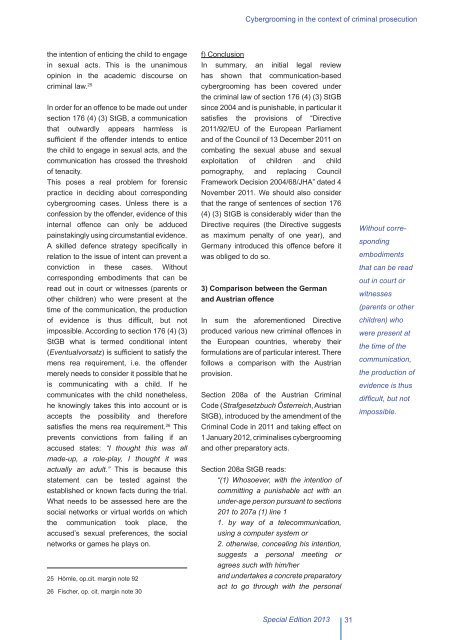ora-schriften-s-2013
ora-schriften-s-2013
ora-schriften-s-2013
Create successful ePaper yourself
Turn your PDF publications into a flip-book with our unique Google optimized e-Paper software.
Cybergrooming in the context of criminal prosecution<br />
the intention of enticing the child to engage<br />
in sexual acts. This is the unanimous<br />
opinion in the academic discourse on<br />
criminal law. 25<br />
In order for an offence to be made out under<br />
section 176 (4) (3) StGB, a communication<br />
that outwardly appears harmless is<br />
sufficient if the offender intends to entice<br />
the child to engage in sexual acts, and the<br />
communication has crossed the threshold<br />
of tenacity.<br />
This poses a real problem for forensic<br />
practice in deciding about corresponding<br />
cybergrooming cases. Unless there is a<br />
confession by the offender, evidence of this<br />
internal offence can only be adduced<br />
painstakingly using circumstantial evidence.<br />
A skilled defence strategy specifically in<br />
relation to the issue of intent can prevent a<br />
conviction in these cases. Without<br />
corresponding embodiments that can be<br />
read out in court or witnesses (parents or<br />
other children) who were present at the<br />
time of the communication, the production<br />
of evidence is thus difficult, but not<br />
impossible. According to section 176 (4) (3)<br />
StGB what is termed conditional intent<br />
(Eventualvorsatz) is sufficient to satisfy the<br />
mens rea requirement, i.e. the offender<br />
merely needs to consider it possible that he<br />
is communicating with a child. If he<br />
communicates with the child nonetheless,<br />
he knowingly takes this into account or is<br />
accepts the possibility and therefore<br />
satisfies the mens rea requirement. 26 This<br />
prevents convictions from failing if an<br />
accused states: “I thought this was all<br />
made-up, a role-play, I thought it was<br />
actually an adult.” This is because this<br />
statement can be tested against the<br />
established or known facts during the trial.<br />
What needs to be assessed here are the<br />
social networks or virtual worlds on which<br />
the communication took place, the<br />
accused’s sexual preferences, the social<br />
networks or games he plays on.<br />
25 Hörnle, op.cit. margin note 92<br />
26 Fischer, op. cit. margin note 30<br />
f) Conclusion<br />
In summary, an initial legal review<br />
has shown that communication-based<br />
cybergrooming has been covered under<br />
the criminal law of section 176 (4) (3) StGB<br />
since 2004 and is punishable, in particular it<br />
satisfies the provisions of “Directive<br />
2011/92/EU of the European Parliament<br />
and of the Council of 13 December 2011 on<br />
combating the sexual abuse and sexual<br />
exploitation of children and child<br />
pornography, and replacing Council<br />
Framework Decision 2004/68/JHA” dated 4<br />
November 2011. We should also consider<br />
that the range of sentences of section 176<br />
(4) (3) StGB is considerably wider than the<br />
Directive requires (the Directive suggests<br />
as maximum penalty of one year), and<br />
Germany introduced this offence before it<br />
was obliged to do so.<br />
3) Comparison between the German<br />
and Austrian offence<br />
In sum the aforementioned Directive<br />
produced various new criminal offences in<br />
the European countries, whereby their<br />
formulations are of particular interest. There<br />
follows a comparison with the Austrian<br />
provision.<br />
Section 208a of the Austrian Criminal<br />
Code (Strafgesetzbuch Österreich, Austrian<br />
StGB), introduced by the amendment of the<br />
Criminal Code in 2011 and taking effect on<br />
1 January 2012, criminalises cybergrooming<br />
and other preparatory acts.<br />
Section 208a StGB reads:<br />
“(1) Whosoever, with the intention of<br />
committing a punishable act with an<br />
under-age person pursuant to sections<br />
201 to 207a (1) line 1<br />
1. by way of a telecommunication,<br />
using a computer system or<br />
2. otherwise, concealing his intention,<br />
suggests a personal meeting or<br />
agrees such with him/her<br />
and undertakes a concrete preparatory<br />
act to go through with the personal<br />
Without corresponding<br />
embodiments<br />
that can be read<br />
out in court or<br />
witnesses<br />
(parents or other<br />
children) who<br />
were present at<br />
the time of the<br />
communication,<br />
the production of<br />
evidence is thus<br />
difficult, but not<br />
impossible.<br />
Special Edition <strong>2013</strong><br />
31





